DNA: the next frontier in forensics
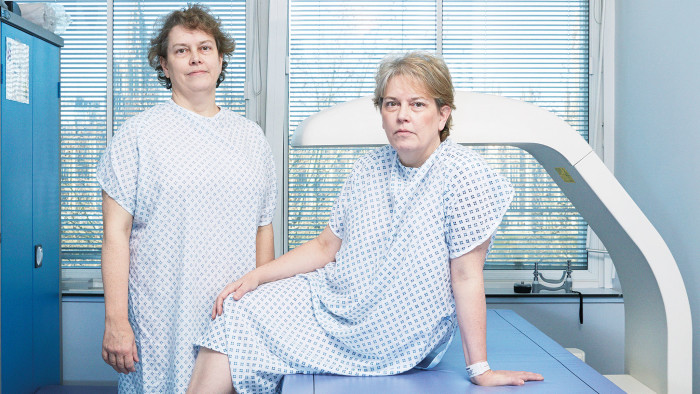
Simply sign up to the Life & Arts myFT Digest -- delivered directly to your inbox.
In January 2011 Candra Alston and her three-year-old daughter Malaysia were murdered at home in Columbia, South Carolina. This month, on the fourth anniversary of the still-unsolved double homicide, Columbia Police put out an unusual picture profile of the suspect. It is believed to be the first image in forensic history to be published entirely on the basis of a DNA sample.
Sleuths, secrets and science: a special issue

Police forensics
On the beat and in the lab with West Midlands police
Faces of the past
The art and science of facial reconstruction
Art and war
Bosnian artist Šejla Kamerić on her search for the missing
Witness to the crime
Photographs that chronicle the underbelly of Mexican life
A grisly history
A slice of brain and other exhibits from forensics’ past
The interview
Forensic anthropologist and author Kathy Reichs
Meet the professional corpse
‘They often throw this blood and guts and stuff on me’
The Undercover Economist
The case against bad statistics
The computer-generated picture comes from a new forensic technique called DNA phenotyping, which provides clues about the physical appearance of a criminal in the absence of a suspect or clear description from witnesses. This is different from the DNA profiling or “fingerprinting” that has become a mainstay of forensic analysis since the 1980s, treating DNA samples from crime scenes as markers to match with known individuals.
Such genetic fingerprinting has led to the conviction of thousands of murderers, rapists and other offenders by linking their DNA to blood, semen, saliva and skin samples. The technology, developed originally at Leicester University in the UK, examines a special group of DNA sequences that vary enormously between individuals, though these are not related to physical appearance.
DNA phenotyping, in contrast, uses genetic variations selected to give maximum information about personal appearance. The technique is still in its infancy, with eye, skin and hair colour and ethnic or racial background the main characteristics that can be determined. Further research is expected to provide stronger links with facial shape and, by tracking “epigenetic” changes in DNA as people grow older, give an indication of age. In the long run, phenotyping could transform the investigation of serious crimes in which the offender leaves a microscopic trace of his or her body fluids or tissues but DNA fingerprinting provides no match. It would be the equivalent of having a physical description from a perfectly reliable witness.
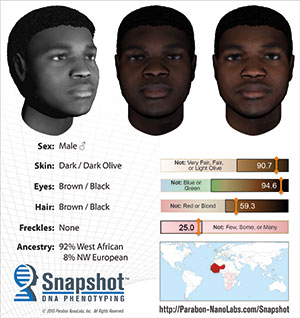
Columbia Police Department is one of a small number of forces, mainly in North America, that are trialling forensic phenotyping. Toronto Police Service is another. “We are beginning to use it as an investigative technique in a number of cases to include or eliminate suspects,” says Stacy Gallant, a veteran homicide detective in Toronto. “It is leading us in certain directions that we would not otherwise have taken.
“We are interested in using phenotyping in cold cases and it has already helped in a couple of them,” he says. In one case, for example, Gallant resolved contradictory descriptions of an offender’s racial background. But it is too soon for anyone to have been charged as a result of this research. “We really take our time when it comes to homicides and sexual assaults,” Gallant adds. “We want to make sure we get it right rather than rushing.”
Like everyone developing the technique, he emphasises that it is an investigative tool rather than a source of evidence that could be used in a trial. When a suspect identified through phenotyping comes to court, conventional DNA fingerprinting will be used to show an exact match between their DNA and a sample from the crime scene.
…
Two specialist companies are leading the commercialisation of forensic phenotyping in partnership with pioneering police forces. Parabon NanoLabs, based in Reston, Virginia, provided Columbia Police with its murder suspect image. Identitas, with facilities in the US, UK and Canada, is working with Toronto. At this early stage the two companies have looked at just a few dozen real cases.
“When you have a couple of companies willing to take the time and spend the money developing products, it shows that the field is ready to move into practice,” says Jenifer Smith, a forensic science professor at Penn State University, who is embarking on a project to exploit next-generation DNA sequencing in criminal investigations. “The new technology will enable us to ‘interrogate’ a tiny stain of body fluid too small to see — and obtain investigative leads from it.”
The companies are building their products on a large base of academic research into the genetic variations that make individuals look different. The currency of this work is the single nucleotide polymorphism. Each SNP (pronounced “snip”) is a change in a single chemical “letter” within the three billion letters of the human genome, which leads to a difference in the individual’s characteristics — his or her phenotype. The effect of one SNP is usually small; the challenge through genetic studies is to construct a panel of many SNPs that collectively determine a feature such as eye colour.
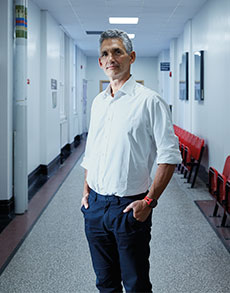
An important source of SNPs is TwinsUK, a huge project started in 1992 by Tim Spector, professor of genetic epidemiology at King’s College, London. Twins who visit his comfortable clinic at St Thomas’ Hospital undergo a thorough medical and physical assessment, from blood tests and bone scans to physical fitness and mental acuity. This can take two to three hours (with the added bonus of one of the capital’s best views across the Thames to the Houses of Parliament).
Long-term studies with Spector’s UK Twins Registry, containing about 12,000 twins, have produced a wealth of data about the genetic and environmental factors affecting health, disease and physical appearance. “They are probably the most investigated people on the planet,” he says. By comparing identical twins, who share all their DNA, and non-identical twins, who share half, scientists discover the roles played by genes and lifestyle in the way people develop.
“The fact that identical twins look so similar shows that visible traits are largely heritable,” says Spector. “We know, for example, that eye colour is almost 100 per cent heritable, while freckles and moles are 70 per cent heritable. Most facial features such as ear lobes and creases on the ears are heritable to a considerable extent.”
To tease SNPs out of the twins data, Spector and colleagues joined five other university research groups to set up an academic consortium, called Visigen, dedicated to discovering the genetic foundations of visible traits. Erasmus Medical Centre in Rotterdam, another member of the consortium, has published two web tools that predict eye and hair colour on the basis of Visigen research.
The first, IrisPlex, turns just six SNPs on different genes into a prediction of eye colour. The second, HIrisPlex, covers both hair and eyes with 24 SNPs. They only need tiny DNA samples: less than 0.1 nanograms. That could come from an almost invisible speck of skin, a hair root, a spot of blood or saliva from a cigarette butt or drinking vessel — though in all forensic investigations the team has to be confident the DNA comes from the suspect rather than contamination.
Accuracy is around 95 per cent for eye colour and 85 to 90 per cent for hair although, as Manfred Kayser, head of the Erasmus MC programme, points out: “The problem with using hair colour as a forensic tool is that it changes with age; blond hair in children often becomes darker in adults.” And, of course, people can dye their hair or wear a wig. Other hair traits potentially predicted by DNA phenotyping include male baldness patterns and texture that is curly or straight, frizzy or fine.
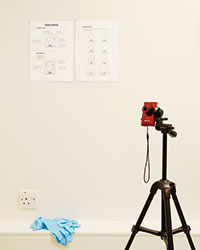
The Erasmus team has also been uncovering the genetic determinants of height, which could eventually be useful for phenotyping. A study showed that extreme tallness can be predicted reasonably well but the height test is not yet ready for forensic application, Kayser says: “The height effect is spread over lots and lots of genes and every SNP has a very small effect.” Another issue is that nutrition and upbringing has a big effect on how tall (and indeed how fat) people grow.
Findings from Visigen were incorporated into the first Identitas Forensic Chip, which includes SNPs associated with freckles, moles, curly hair, ear-lobe shape, body height and eye, hair and skin colour — though the company concedes that not all of these have high predictive value yet. Reports sent to police after sample analysis focus on biogeographic ancestry as well as eye and hair colour.
In one sample Identitas report, the ancestry of a suspect is given as 95 per cent European, with 99 per cent probability of blue or intermediate eye colour and just 1 per cent probability of brown eyes; hair colour probability is 94 per cent brown or black hair and 6 per cent blond or red. It also notes that the individual’s parents do not share origins in a closed or isolated population.
“Ancestry particularly interests the police,” says Laurence Rubin, Identitas chief executive. “We can tell where the mother or father comes from.” The company began a validation exercise last summer, using 36 samples provided by US and Canadian police. “These were real casework samples of varying quality,” he adds. “Some did not work but 26 of them produced actionable data.”
“In one sample I looked at, it was clear that the person was half African and half European in ancestry,” adds Aruna Bansal, who is in charge of data analysis for Identitas. “That was very useful information because the individual came from an area that is not ethnically diverse.”
The other company, Parabon, also uses a base of academic research, to which it adds its proprietary computer analysis and data mining resources. Its forensic reports — given the trade name Snapshot — cover much the same ground as those from Identitas, supplemented with a photographic representation, as in the Columbia case. The US Department of Defense has provided about $2m in development funding.
“This technology moves DNA to the forefront of the investigation,” says Steven Armentrout, Parabon’s chief executive. Its ability to exclude potential suspects may be as useful to detectives as its incriminating power, he adds: “If we can remove a large number of people from investigation that saves a lot of time and resources.” Snapshot usually costs less than $5,000 per case.
…
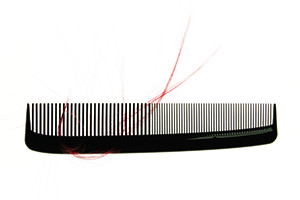
As DNA forensics researchers work to increase the spread of traits they can capture from tiny DNA traces, they are wary about one category: SNPs that indicate susceptibility to specific disease. It might be useful to know, for example, that a suspect is likely to be diabetic or suffering from an inherited disability but Susan Walsh, forensic geneticist at Indiana University-Purdue University, cautions: “We have to be very careful here. Ethics is quite a strong barrier.” Ellen Greytak, bioinformatics director of Parabon, agrees: “Disease genes get us into some hairy privacy issues. We’re going to stick with things that are extremely visible.”
The most important factor missing from DNA phenotyping in these early stages is an indication of age. The Snapshot picture of the suspect in the Columbia murder shows a young man but has to carry a warning: “This person may appear older than shown here.” Gallant in Toronto adds: “It would be fantastic if the technology could give us an age range for the person who left the DNA.”
Age is a challenge because, while random mutations take place as you get older, your core DNA remains the same. So age cannot be treated in the same way as other appearance traits. But the emerging field of epigenetics will help here; it looks at the way the genome responds to the environment — how genes are switched on and off over time in different tissues and under changing circumstances.
The most important epigenetic change is methylation, which adds methyl groups (chemical tags) to DNA. Spector, who studies this process in his twins as they age, is optimistic about its use in forensics. “Within five years we should be able to tell to within five to 10 years how old someone is,” he says.
Mainstream DNA fingerprinting is well established as the bread and butter of forensic investigation. Rather than the SNP, its currency is the short tandem repeat or STR, chosen 30 years ago to distinguish between individuals with the instrumentation available then. Jim Thomson, DNA research and development director at LGC, a leading UK forensics company, says the panel of STRs has been extended progressively from the original six to 10 and now 16 — which is as much as we need for accurate matching, even from poor quality samples.

Because DNA databases worldwide, holding millions of profiles, are built on these STRs, “we need to continue with them for a long time into the future”, says Thomson. “We can’t ditch them by moving to a new panel of tests.”
Most people in DNA forensics say that if you were starting with today’s knowledge of genomics and DNA sequencing technology, you would use SNPs rather than STRs, because large panels of them would be just as effective for fingerprinting and deliver the phenotyping ability too.
While STRs will continue, advancing technology will eventually make it possible to run both STRs and SNPs in parallel on one forensic chip. “Will we ultimately move from STRs to SNPs?” asks Jenifer Smith. “I would say yes but it will take a lot of money and planning to make it happen.”
Meanwhile in South Carolina, Carl Alston, father of Candra Alston and grandfather of Malaysia, is hoping that the new DNA-based image of their murderer will help to bring someone to justice. “It’s hard for me to come to grips with what happened” he says. “I still have trouble really believing my daughter and granddaughter are gone.”
Remains of the DNA: King Richard III
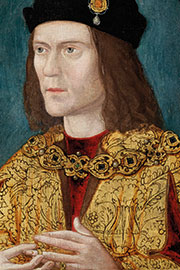
The oldest forensic DNA case to date is the identification in 2012 of the skeleton discovered under a Leicester car park as the remains of King Richard III, who was killed nearby at the Battle of Bosworth in 1485.
There was plenty of historical and medical evidence linking the bones to the last Plantagenet king, who was buried after the battle in Greyfriars church — demolished centuries ago. They belonged to a man in his early thirties corresponding with Richard’s death at the age of 32, they showed appropriate battle injuries and had scoliosis of the spine, which matched contemporary descriptions of the king having one shoulder higher than the other.
But confirmation came from analysis of DNA that survived inside the bones. An international scientific team led by the University of Leicester estimated that, on the most conservative statistical analysis, the probability of the skeleton being Richard III was 99.999 per cent.
The DNA evidence, published last month in the journal Nature Communications, used painstaking genealogical research to trace living relatives of Richard III and compare their genetic markers with those from the skeleton. Because Richard had no children, the research had to go back in time before moving forward to descendants alive today.
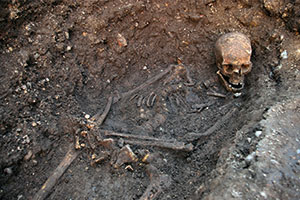
Confirmation came from the mitochondrial genome — DNA from outside the cellular nucleus — which people inherit entirely from their mothers and only women can pass on to the next generation. Mitochondrial DNA from the Leicester skeleton matched that of two matrilineal relatives who volunteered for genetic analysis: Wendy Duldig (Richard’s grandniece 18 times removed) and Michael Ibsen (his grandnephew 16 times removed).
Unfortunately, a similar analysis of the Y-chromosome, which is passed down by paternal descent, failed to match living male relations. This does not invalidate the identification, says Turi King, who led the DNA work, because a chain of male succession with 22 links is quite likely to be broken by at least one case of “false paternity” — in other words, unsuspected adultery.
The team also carried out DNA phenotyping. Using the HIrisPlex panel of tests, they showed a 96 per cent probability of blue eyes and a 77 per cent probability of hair that was blond in boyhood (this might well have darkened into adulthood but would not have been an intense brown or black).
Although no contemporary portraits of Richard survive, the results are consistent with the so-called “arched frame” painting in London’s Society of Antiquaries, painted 20 to 30 years after his death but believed to be based on a lost portrait completed during his lifetime.
We will hear more about Richard III this year. Following confirmation of his identity, the skeleton will be reinterred in Leicester Cathedral on March 26 in a ceremony fit for a king. And, on the scientific front, the Leicester team is carrying out further analysis of his genome in the hope that it will reveal more about Richard, including features that would be beyond the scope of a contemporary forensic investigation
Clive Cookson is the FT’s science editor
Photographs: Parabon; Felicity McCabe; Society of Antiquaries of London
Comments